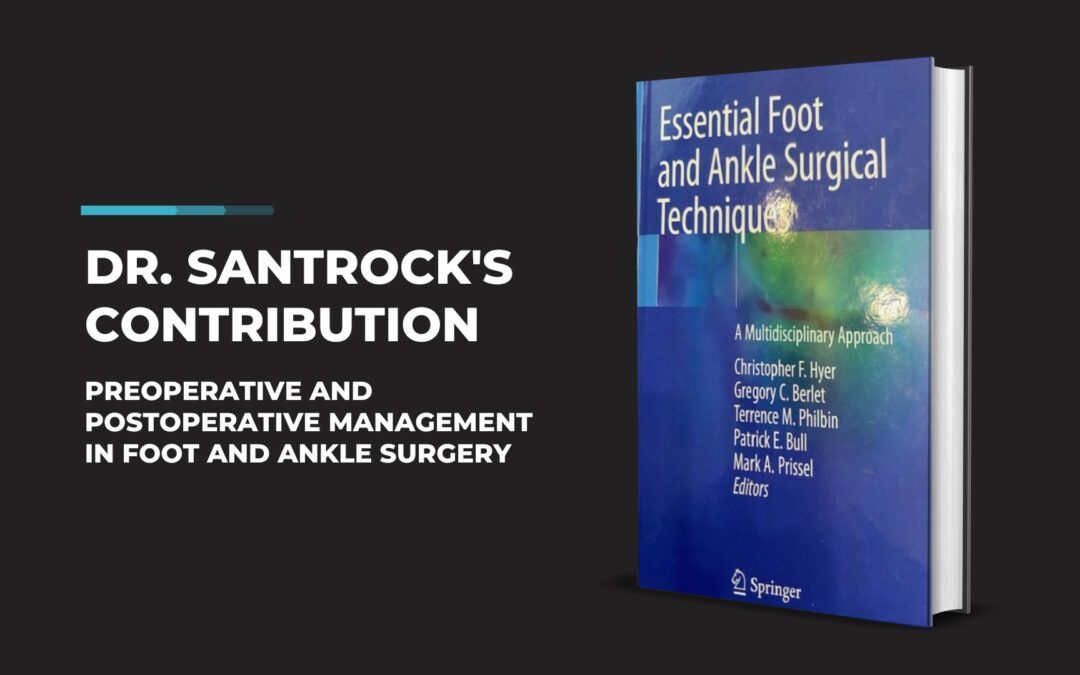The Foundation of the 3Rs Philosophy
Dr. Robert D. Santrock’s “3Rs” philosophy – Replenish, Rebuild, and Restore – forms the foundation of his approach to foot and ankle surgery. This holistic framework emphasizes the importance of nutritional support, structural repair, and functional recovery, ensuring comprehensive care for each patient. Long before his involvement with Dovetail Orthopedics, Dr. Santrock was developing this philosophy, as reflected in his early publications. His work laid the groundwork for a thorough approach to surgery, spanning from preoperative preparation to postoperative protocols. In his chapter in the textbook Essential Foot and Ankle Surgical Techniques, Dr. Santrock offers invaluable insights into managing foot and ankle surgeries, reinforcing the importance of the 3Rs. Let’s explore the key aspects covered in this essential chapter.
Preoperative Optimization for Foot and Ankle Surgery Management
Nutritional Status
Dr. Santrock emphasizes the importance of assessing the patient’s nutritional status, particularly for those with chronic conditions such as diabetes. Nutritional markers such as prealbumin, albumin, and total lymphocyte counts provide a snapshot of the patient’s overall health, serving as predictors of surgical morbidity and mortality. For instance, diabetic patients often present with malnutrition, which can affect their surgical outcomes. A preoperative albumin level of over 2.5 g/dL and a lymphocyte count of over 1500/uL are recommended as guidelines for proceeding with significant foot and ankle surgeries.
Blood Glucose Control
Effective blood glucose control is crucial, especially for diabetic patients. Dr. Santrock stresses the importance of maintaining an HbA1c level of 7.0% or less, and a blood glucose level under 150 mg/dL during hospital admission, to optimize healing. This minimizes physiological damage and promotes effective recovery. In cases of poor glycemic control, consultation with an endocrinologist may be necessary.
Vascular Assessment
Foot and ankle surgeries can pose risks related to the vascular status of the patient, especially in those with peripheral vascular disease (PVD). An ankle-brachial index (ABI) of greater than 0.5 indicates sufficient vascular status for surgery. Dr. Santrock also recommends visualizing triphasic waveforms on Doppler to confirm vessel response, especially if the ABI is higher than 1.25 or lower than 0.5. In such cases, arteriography and vascular intervention may be necessary.
Anticoagulation Medications and DVT Risks
Patients on anticoagulants for conditions such as atrial fibrillation or prior cerebrovascular events pose unique postoperative challenges. Dr. Santrock advises stopping all anticoagulants except for 81 mg aspirin. In cases where substitution is necessary, Lovenox (enoxaparin) is recommended due to its short half-life, reducing the risk of complications.
Rheumatoid Arthritis
Dr. Santrock highlights the challenges posed by patients with rheumatoid arthritis, particularly those on disease-modifying antirheumatics (DMARDs). These medications can impede healing and increase infection risk. Close consultation with the prescribing rheumatologist is advised to manage medication dosages effectively, particularly during the perioperative period.
Chronic Edema and CVI
Dr. Santrock addresses the unique challenges of managing patients with chronic edema and chronic venous insufficiency (CVI). These conditions increase the risk of postoperative complications, including infection and wound dehiscence. To mitigate these risks, meticulous skin handling, elevation, and frequent dressing changes are recommended.
Nicotine Use
Nicotine use poses significant risks to surgical healing, both for skin and bone healing. Dr. Santrock emphasizes the need to discourage nicotine use, as it acts as a vasoconstrictor, impairing blood flow and healing.
The Surgical Workflow for Foot and Ankle Surgery Management
Screening Tools
Dr. Santrock introduces screening tools to help assess the patient’s suitability for elective foot and ankle surgery. These tools not only aids in pre-authorizing the surgery but also facilitates communication with the surgical team.
Planning Conference and Surgical Checklist
Dr. Santrock stresses the importance of a weekly planning conference to review each case in detail. This conference serves as an educational tool for the surgical team and ensures that all necessary equipment is available. Furthermore, the surgical checklist serves as a final check before the operation, ensuring consistency and alignment across the surgical team.
Postoperative Protocols for Foot and Ankle Surgery Management
Dr. Santrock concludes by emphasizing the importance of postoperative protocols, which streamline recovery and rehabilitation. The surgical team follows six unique groups of protocols, discussed during the surgical consent visit. This consistency reduces patient confusion, improves office visits, and facilitates research and data collection.
A Comprehensive Roadmap for Preoperative and Postoperative Management
Dr. Robert D. Santrock’s chapter provides a comprehensive roadmap for preoperative and postoperative management in foot and ankle surgeries. From nutritional assessments and vascular evaluations to planning conferences and postoperative protocols, this chapter offers invaluable guidance for healthcare professionals and patients alike. Dr. Santrock’s contribution stands as a testament to the meticulous planning and comprehensive care necessary for successful foot and ankle surgeries.

